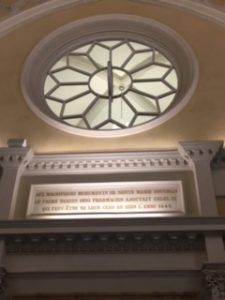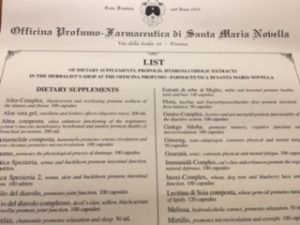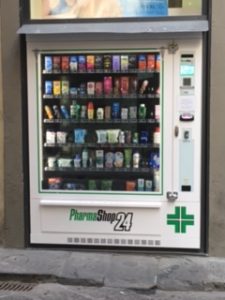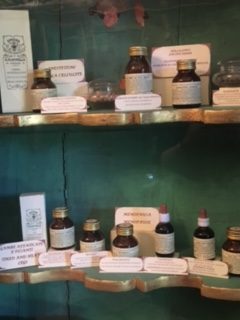CNN called it, “the ancient perfume store you never heard of,” but the Officina Profumo-Farmaceutica di Santa Maria Novella had its literal roots in medicinal herbs. With scents wafting onto a 13th century Florence piazza, the Farmacia now operates as a pharmacy storefront for homeopathic and herbal supplements, along with perfumes and home scents. A visit to the pharmacy today is a journey into medicinal time-travel, back to the year 1221.
 I spent time in the pharmacy today to learn about the literal roots of the shop in medicinal herbs cultivated in a monastery garden and reformulated by monks into remedies, teas, skin-care products and scents. With ancient formulas, the Farmacia has modern traction: it’s rated #3 among 303 shopping destinations in Florence in TripAdvisor as of today’s date.
I spent time in the pharmacy today to learn about the literal roots of the shop in medicinal herbs cultivated in a monastery garden and reformulated by monks into remedies, teas, skin-care products and scents. With ancient formulas, the Farmacia has modern traction: it’s rated #3 among 303 shopping destinations in Florence in TripAdvisor as of today’s date.
The story of this pharmacy starts with the church, Santa Maria Novella, which was founded by Dominican monks in 1221. These friars began to cultivate medicinal herbs in their garden to make medications, balms and ointments for the church’s infirmary. Catherine de’Medici was an early patroness in the 1500s.
 The monks’ herbalist-growing tradition continued to 1612, when Fra’Angiolo Marchissi opened the pharmacy to the public. In the 1700s, the pharmacy’s products grew an international following, into Russia, the Indies, and China.
The monks’ herbalist-growing tradition continued to 1612, when Fra’Angiolo Marchissi opened the pharmacy to the public. In the 1700s, the pharmacy’s products grew an international following, into Russia, the Indies, and China.
The enterprise was eventually purchased by a nephew of the pharmacy’s last friar-director in the 20th century, and continues to be operated by that family in its fourth generation.
 Among the pharmacy’s products for medicinal use are Liquor Mediceo, Alkermes (“a way to revive weary and lazy spirits”), Elisir di China, Aceto dei Sette Lardiere (smelling salts)., and Acqua di Santa Maria Novella – the last known as “Acqua Antisterica” made from the Santa Maria (Costmary) herb used for digestion. The plant on which this formula is based is still grown by Dominican monks in the Santa Maria Novella garden.
Among the pharmacy’s products for medicinal use are Liquor Mediceo, Alkermes (“a way to revive weary and lazy spirits”), Elisir di China, Aceto dei Sette Lardiere (smelling salts)., and Acqua di Santa Maria Novella – the last known as “Acqua Antisterica” made from the Santa Maria (Costmary) herb used for digestion. The plant on which this formula is based is still grown by Dominican monks in the Santa Maria Novella garden.
The farmacia offers a long list of dietary supplements in its shop (note that the US online store offers none of these products via e-commerce). The list of herbal-based products runs from “A” to “V,” beginning with Aller-Complex which is made with blackcurrant to promote wellness of sinus and throat, Aleta composta, of horehound and sundew to promote respiratory health, and Antica Spezieri made with senna and buckthorn of intestinal function; and “V” products including Valerian to promote relaxation, and Vigor-Complex with cola, guaranteed, and ginseng to help with mental and physical fatigue. There are dozens more supplements sold to help liver function, cellulite, menopause, metabolic function, eyesight, circulation, and intestinal flora balance (a hot topic these days with growing interest in gut microbiomes).
 Health Populi’s Hot Points: What is a pharmacy in 2017? CVS/pharmacy quit tobacco in 2014 and re-branded as CVS/health. Most grocery store chains universally have co-located pharmacies to channel prescription drugs to food shoppers. Pharmacies are in hospitals, Big Box stores, and some still independently operated. The photograph here pictures a 24-hour kiosk I encountered walking around Florence this week; the machine serves as a kind of 24/7 pharmacy for over-the-counter and personal care products.
Health Populi’s Hot Points: What is a pharmacy in 2017? CVS/pharmacy quit tobacco in 2014 and re-branded as CVS/health. Most grocery store chains universally have co-located pharmacies to channel prescription drugs to food shoppers. Pharmacies are in hospitals, Big Box stores, and some still independently operated. The photograph here pictures a 24-hour kiosk I encountered walking around Florence this week; the machine serves as a kind of 24/7 pharmacy for over-the-counter and personal care products.
As patients continue to grow health consumer savvy by taking on more financial and clinical decisions and engagement, the pharmacy can be that health consumer’s go-to platform for convenient, cost-effective care. That care can take many forms based on personal choices and reasons: perhaps as a site for an immunization (say, a flu shot), a source for 1:1 consultation with a pharmacist about a medical condition, or via a store-branded app that provides access to a telehealth consultation with a doctor.
Americans spend upwards of $30 billion a year on complementary and alternative medicine, according to the National Center for Complementary and Integrative Health (part of the US Department of Health and Human Services’ National Institutes of Health). People in America spend $millions on supplements for red yeast rice, for example, which some U.S. physicians now “prescribe” (small ‘p’) to help manage cholesterol before Prescribing (capital ‘P’) statins. At least one-third of American adults use some form of CAM (complementary and alternative medicine) in daily life.
In the case of the Pharmacy of Santa Maria Novella, the “farmacia” is a place for wellness and retail health, based in spirituality and Mother Nature’s formulary. This is a language health consumers, the world over, speak.





 I am so grateful to Tom Lawry for asking me to pen the foreword for his book, Health Care Nation,
I am so grateful to Tom Lawry for asking me to pen the foreword for his book, Health Care Nation,  I love sharing perspectives on what's shaping the future of health care, and appreciate the opportunity to be collaborating once again with Duke Corporate Education and a global client on 6th May. We'll be addressing some key pillars to consider in scenario planning such as growing consumerism in health care, technology (from AI to telehealth), climate change, and trust -- the key enabler for health engagement or dis-engagement and mis-information. I'm grateful to be affiliated with the corporate education provider
I love sharing perspectives on what's shaping the future of health care, and appreciate the opportunity to be collaborating once again with Duke Corporate Education and a global client on 6th May. We'll be addressing some key pillars to consider in scenario planning such as growing consumerism in health care, technology (from AI to telehealth), climate change, and trust -- the key enabler for health engagement or dis-engagement and mis-information. I'm grateful to be affiliated with the corporate education provider  Thank you FeedSpot for
Thank you FeedSpot for